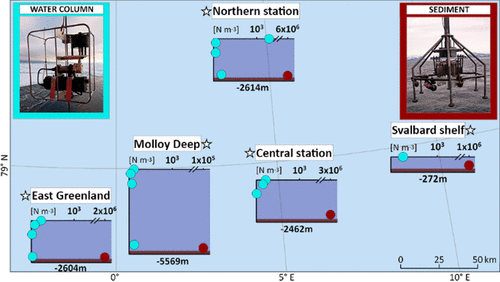当前位置:
X-MOL 学术
›
Environ. Sci. Technol.
›
论文详情
Our official English website, www.x-mol.net, welcomes your
feedback! (Note: you will need to create a separate account there.)
Tying up Loose Ends of Microplastic Pollution in the Arctic: Distribution from the Sea Surface through the Water Column to Deep-Sea Sediments at the HAUSGARTEN Observatory.
Environmental Science & Technology ( IF 10.8 ) Pub Date : 2020-03-25 , DOI: 10.1021/acs.est.9b06981 Mine B Tekman 1 , Claudia Wekerle 2 , Claudia Lorenz 3 , Sebastian Primpke 3 , Christiane Hasemann 1 , Gunnar Gerdts 3 , Melanie Bergmann 1
Environmental Science & Technology ( IF 10.8 ) Pub Date : 2020-03-25 , DOI: 10.1021/acs.est.9b06981 Mine B Tekman 1 , Claudia Wekerle 2 , Claudia Lorenz 3 , Sebastian Primpke 3 , Christiane Hasemann 1 , Gunnar Gerdts 3 , Melanie Bergmann 1
Affiliation

|
Recent studies have shown that despite its remoteness, the Arctic region harbors some of the highest microplastic (MP) concentrations worldwide. Here, we present the results of a sampling campaign to assess the vertical distribution of MP particles (>11 μm) at five stations of the HAUSGARTEN observatory. Water column samples were taken with large volume pumps by filtering 218–561 L of seawater at two to four depth strata (near-surface, ∼300 m, ∼1000 m, and above seafloor), and sediment samples were taken with a multiple corer. MP concentrations in the water column ranged between 0 and 1287 N m–3 and in the sediment from 239 to 13 331 N kg–1. Fourier transform infrared spectroscopy (FTIR) imaging with automated data analysis showed that polyamide (39%) and ethylene-propylene-diene rubber (23%) were the most abundant polymers within the water samples and polyethylene-chlorinated (31%) in sediments. MPs ≤ 25 μm accounted for more than half of the synthetic particles in every sample. The largest MP particle recorded was in the 200 μm size class. The concentrations of fibers were not reported, as fiber detection by FTIR imaging was not available at the time of analyses. Two- and three-dimensional simulations of particle transport trajectories suggest different pathways for certain polymer types. A positive correlation between MP size composition and particulate organic carbon indicates interactions with biological processes in the water column.
中文翻译:

捆扎北极微塑性污染的松散末端:在HAUSGARTEN天文台从海面通过水柱到深海沉积物的分布。
最近的研究表明,尽管地处偏僻,但北极地区还是全球范围内某些最高的微塑性(MP)浓度最高的地区。在这里,我们介绍了一项采样活动的结果,以评估HAUSGARTEN天文台的五个站的MP颗粒(> 11μm)的垂直分布。水柱样品是使用大容量泵通过过滤两到四个深度层(近地表,〜300 m,〜1000 m和海底以上)的218–561 L海水而获得的,沉积物样品是采用多芯取样器采集的。水柱中的MP浓度范围为0至1287 N m –3,沉积物中的MP浓度为239至13331 N kg –1。具有自动数据分析的傅立叶变换红外光谱(FTIR)图像显示,聚酰胺(39%)和乙烯-丙烯-二烯橡胶(23%)是水样品中含量最高的聚合物,而沉积物中的聚乙烯氯含量最高(31%)。MP≤25μm占每个样品中合成颗粒的一半以上。记录的最大MP颗粒为200μm尺寸级别。没有报告纤维的浓度,因为在分析时无法通过FTIR成像进行纤维检测。粒子传输轨迹的二维和三维模拟显示了某些聚合物类型的不同途径。MP大小组成与颗粒有机碳之间的正相关关系表明与水柱中生物过程的相互作用。
更新日期:2020-03-26
中文翻译:

捆扎北极微塑性污染的松散末端:在HAUSGARTEN天文台从海面通过水柱到深海沉积物的分布。
最近的研究表明,尽管地处偏僻,但北极地区还是全球范围内某些最高的微塑性(MP)浓度最高的地区。在这里,我们介绍了一项采样活动的结果,以评估HAUSGARTEN天文台的五个站的MP颗粒(> 11μm)的垂直分布。水柱样品是使用大容量泵通过过滤两到四个深度层(近地表,〜300 m,〜1000 m和海底以上)的218–561 L海水而获得的,沉积物样品是采用多芯取样器采集的。水柱中的MP浓度范围为0至1287 N m –3,沉积物中的MP浓度为239至13331 N kg –1。具有自动数据分析的傅立叶变换红外光谱(FTIR)图像显示,聚酰胺(39%)和乙烯-丙烯-二烯橡胶(23%)是水样品中含量最高的聚合物,而沉积物中的聚乙烯氯含量最高(31%)。MP≤25μm占每个样品中合成颗粒的一半以上。记录的最大MP颗粒为200μm尺寸级别。没有报告纤维的浓度,因为在分析时无法通过FTIR成像进行纤维检测。粒子传输轨迹的二维和三维模拟显示了某些聚合物类型的不同途径。MP大小组成与颗粒有机碳之间的正相关关系表明与水柱中生物过程的相互作用。











































 京公网安备 11010802027423号
京公网安备 11010802027423号